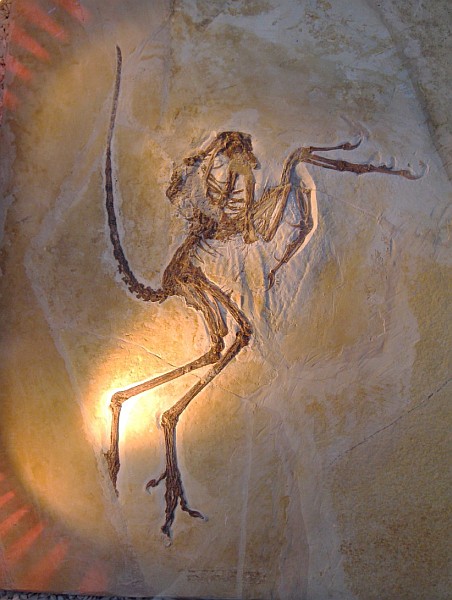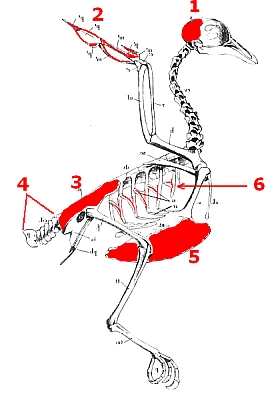
Last week I wrote about the Urvogel Feather of Archaeopteryx lithographica, the oldest feather ever found. Now that I’m beginning the Tenth Page series I’ve discovered that page 30 of Ornithology has a neat comparison of Archy’s skeleton to that of modern birds.
Archaeopteryx lithographica is recognized as a link between dinosaurs and birds because he has features of both. Like dinosaurs he has**:
- jaws with sharp teeth
- three fingers with claws
- a long bony tail
- hyperextensible second toes that are “killing claws”
- feathers, which also suggest homeothermy (This characteristic is rather self-fulfilling in that dinos were not thought to have feathers until Archy was discovered.)
- and various dinosaur skeletal features.
Like birds he has:
- flight feathers, the asymmetrical feathers on his wings
- broad wings
- hollow bones
- a furcula, the “wishbone”
- and reduced fingers.
But as a bird he’s not quite there yet. Modern birds have skeletal adaptations that make flight much easier than it must have been for Archy. This is evident in a skeletal comparison.
Page 30 of Ornithology describes how modern birds improved on Archaeopteryx lithographica’s features:
- Skull: In modern birds the braincase is expanded and the bones are fused.
- Hands: Most of the bones are fused
- Pelvis: Bones are fused to make a sturdier structure
- Tail: Bones are fused, the tail is shorter
- Sternum: Expanded to a large keel for attaching the flight muscles
- Rib cage: Has cross-struts (“horizontal uncinate processes”) for strength.
So, if you have a lot of time to improve your flight abilities — say 150 million years — this is what you get.
Inspiration for this Tenth Page is from page 30 of Ornithology by Frank B. Gill.
(credits:
** The dino list is quoted from the Wikipedia article on Archaeopteryx.
Photo of Archaeopteryx lithographica, Solenhofener specimen from Wikimedia Commons. Skeleton of modern bird from Illustrations of Zoology by W. Ramsay Smith and J S Newell, in the public domain via Wikimedia Commons, red annotations added by Kate St. John. Click on the images to see the originals.)
